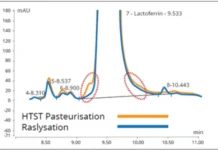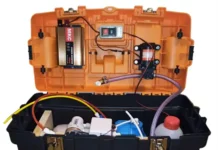Danny Bayliss, New Technology Research Manager, Campden BRI
Peter Gordon, VP of sales and marketing, Senko Advanced Components
July 2022 witnessed spiking energy costs and soaring food prices throughout Europe and North America due to global warming-induced broiling temperatures and global inflation-induced record prices. These factors now are combined as a novel term to describe what we all are suffering: heatflation. Any proven means to use less electricity and lower food costs should be welcome relief.
Germicidal UV-C appropriately received significant interest from investors, industry, regulators and users in recent years due to the technology’s ability to mitigate the COVID-19 pandemic. It now may be timely to slightly shift focus and apply adoption resources to enhance its visibility as a viable technology for sustainable food production operations. UV-C applications in the food supply chain have been expanding over the last two decades for the treatment of food plant surfaces, food packaging and basic foodstuff. More recently, researchers and engineers have demonstrated extended shelf-life, alternatives to preprocess washing and decreased need for pesticides to control plant pests in the field. Such applications of UV-C promoting sustainability have gained the focus – and scrutiny – of government regulators, equipment companies and consumers who practice Lifestyles of Health and Sustainability (LOHAS) and who vigilantly check off all the boxes when making purchasing decisions.
One burgeoning capability being deployed in food manufacturing is the use of tunnels to decontaminate conveyed packaged goods, grappling utensils and processing tools. Such discrete items need to be transferred systematically around factory floors, and moving them into high-risk areas requires great care. A manufacturer must implement suitable methods for preventing cross-contamination to avoid compromising designated factory zones and attracting regulators’ inspection approaches. Accountants seek cost-saving methods. Given the market pressures of a cash-strapped consuming public, utilization of UV-C will benefit all stakeholders.
More traditional processes involve using copious amounts of water and releasing sanitizing sprays within tunnels. These have limited efficacy, are corrosive and leave standing wastewater that encourages biofilm formation, further challenging the “avoid cross-contamination” mantra. The effectiveness of chemical spray tunnels is dependent on two critical parameters: the concentration of the chemical sanitizer and the contact time on the surface. Chemical sanitizers for surface disinfection are tested to an agreed standard, with a residence time of 20 minutes. Most spray operation tunnels will not guarantee this residence time and likely only will produce exposures of 60 seconds in the tunnel. Depending on the manufacturer, some will stack the processed packs before use so the remaining chemical residues have time to act on the surface, but guaranteeing long exposures in a production environment is highly unlikely given production time constraints.
Normally, the last item processed will be at the top of the stack and first to be used, so it likely will receive the shortest time, resulting in lower log reductions, depending on production pressures. Transferring 150 packs in a production shift could take 2.5 hrs for a 60 s residence time. Handling and wiping packs will add further staff time. If there is no additional residence time, then lower log reductions of target microorganisms would be expected. Chemical spray tunnels have been optimized to utilize water reuse and minimize waste, but even a smaller spray tunnel may use 250 L of water with a 1% to 1.5% final sanitizer concentration. Assuming a change of the water once per production day, it could consume 500 L of water per day. If this occurs for five working days and 52 weeks per year, 130,000 L of water would be used each year for just one tunnel. While the cost to supply the water and treat the wastewater is relatively low, the aggregated resource burden placed on the electrical grid and water supplies from all food and drink manufacturers is high, so any methods to support the reduction of their use should be considered. Finally, the continuous dosing of chemicals to maintain the correct concentrations is an added cost to companies, and that is passed on to inflation-overwhelmed consumers, who need a break.
Given all these shortcomings and demanding an alternative, what “sustain-ability” does UV-C hold? UV-C-based processing packs have been demonstrated to reduce the reliance on wipes to dry surfaces when no water is involved in the decontamination. This also would free time for staff who normally would have to stack and wipe down items before use. The process would be achieved within the transference through the tunnel, so an allotted wait time would not be required, and more consistency and confidence can be assured for the microbial control measure in place. Looking at the electrical energy consumption, this can vary greatly for both types of systems, depending on the volumes and pumps required for the spray tunnels and the number of belts being conveyed.
On the UV-C side, the number of lamps will influence the main energy consumption. Within a typical wash tunnel system, a 1 horsepower pump may be used, which would consume around 1,900 W. A bit more energy consumption also may be added to this for conveyor motors, etc. Looking at a tunnel system at Campden BRI, one can run 16 low-pressure mercury lamps rated at 90 W each with a conveyor motor. Having a similar residence time of 60 seconds, designers can have the lamps set at different heights. Delivering an 80 mJ/cm2 dose, the system consumes 1,560 W – so with the right configuration and target levels, there also may be some energy savings when switching to some UV-C tunnels systems. The dosage required to achieve 3 to 5 log reductions on a smooth surface (like a packaging material) can be very low with the correct surface exposure (5 to 40 mJ/cm2), which further supports manufacturers in generating greater throughput in their facilities while reducing energy required per pack.
In summary, with such smart stewardship of water, lowered dependence on chemistry, less electric energy dependence and sufficient efficacy, all stakeholders now can envision the ability of UV-C equipment to sustain environmental soundness and lower overall costs to produce and consume food – perhaps battling heatflation with ready-to-eat frozen entrees at an affordable price.
Contact: Danny Bayliss, danny.bayliss@campdenbri.co.uk; Peter Gordon, peter.gordon@senko.com






